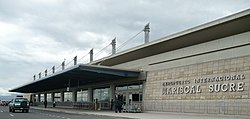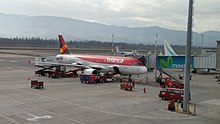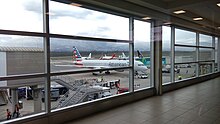Mariscal Sucre International Airport
Mariscal Sucre International Airport Aeropuerto Internacional Mariscal Sucre | |||||||||||
|---|---|---|---|---|---|---|---|---|---|---|---|
 | |||||||||||
| Summary | |||||||||||
| Airport type | Public | ||||||||||
| Operator | Quiport,[1] CORPAQ[2] | ||||||||||
| Serves | Quito | ||||||||||
| Location | Tababela, Quito Canton, Pichincha | ||||||||||
| Opened | 20 February 2013 | ||||||||||
| Hub for | |||||||||||
| Elevation AMSL | 2,400 m / 7,874 ft | ||||||||||
| Coordinates | 0°06′48″S 78°21′31″W / 0.1133°S 78.3586°WCoordinates: 0°06′48″S 78°21′31″W / 0.1133°S 78.3586°W | ||||||||||
| Website | www www | ||||||||||
| Map | |||||||||||
 UIO Location of airport in Ecuador | |||||||||||
| Runways | |||||||||||
| |||||||||||
Mariscal Sucre International Airport[3] (Spanish: Aeropuerto Internacional Mariscal Sucre) (IATA: UIO, ICAO: SEQM) is the busiest airport in Ecuador and one of the busiest airports in South America. It is located in the Tababela parish, about 18 kilometres (11 mi)[4] east of Quito and serves as the largest hub for Avianca Ecuador and LATAM Ecuador. It also served as the main hub for TAME, Ecuador's flag-carrier, before the airline was liquidated by the Ecuadorian government in 2020.[5] The airport opened in February 2013 and replaced the 53-year old airport of the same name.[6] The airport is named after independence leader Antonio José de Sucre. It is rated as the only 5-star airport in the Western Hemisphere by Skytrax.[7][8]
Location[]
The new Quito International Airport is located on the Oyambaro plain near the town of Tababela, about 18 kilometers (11 mi) east of Quito, Ecuador. The location was chosen in order to expand the capacity of the city's airport.
The old airport posed enormous risks because it was located in the middle of a mountainous city with high wind currents. It could no longer be expanded to accommodate larger aircraft or increased air traffic, and had been the scene of numerous incidents and accidents during the latter years of its operation.[9][10]
History[]









Construction began in 2006.[11] A re-negotiation of the financing contract for the airport was signed on 9 August 2010.[12]
At about 6:19 a.m. on July 2, 2012, an American Airlines Boeing 757 landed at the new airport with about 100 passengers on board. The flight was used to obtain the operating certificate for track tests. It also allowed testing of the performance of the electronics mounted for handling and transporting luggage and check-in counters for passengers and baggage. The aircraft departed from the existing Mariscal Sucre International Airport with Quito's Mayor, Augusto Barrera, local authorities, aviation staff, and the media to pre-test[clarification needed] boarding procedures at 5:30 a.m., later taking off at about 6:10 a.m. After a 9-minute flight, the flight landed at the new Airport. After landing and subsequent taxiing through taxiway 1 of the new airport, the airplane was greeted with a water cannon salute from two fire trucks.
Subsequently, visitors toured the facilities of the passenger terminal building and the north and south ends of the runway. After the tour, Mayor Barrera and authorities gave a press conference. There, the Mayor also stated that the airport would be ready at its inauguration, as well as enhancements to the E-35, and Interoceanic highways. "This is a day of joy and optimism for the city. At this point all you get joining goodwill," the official said adding that the social energy that the city should serve to build and make things.
Mayor Barrera also stated that this airport will be a remarkable leap in economic development of the city of Quito and that the strategic alliance with Quiport achieved with the resources generated by the new airport will be for all the people of Quito. "We are checking with the facts that transformation we're doing for the Quito we crave" he said. The mayor also reported that when the Mariscal Sucre Airport closes, construction of a new park will begin at the current site, and within days the bidding will begin for the 1st phase of the planned Quito Metro, as well as for the construction of a new bridge over the Chiche river.
The official inauguration was postponed from October, 2012, citing the progress of improvements to various access routes, the holiday season, and other factors. The new airport commenced operations on 20 February 2013 following the closure of the old airport the night before. The first flights scheduled to arrive at the new airport were TAME flight 302 from Guayaquil (domestic), and LAN flight 2590 from Lima, Peru (international). Arrival times were scheduled for 9:00 and 9:30 a.m. respectively.[13]
Airlines and destinations[]

Passenger[]
| Airlines | Destinations |
|---|---|
| Aeroméxico | Mexico City |
| Aeroregional | Baltra, Coca, Cuenca, Guayaquil, Loja |
| Air Europa | Madrid1 |
| American Airlines | Miami |
| Avianca | Bogotá |
| Avianca Costa Rica | San Salvador |
| Avianca Ecuador | Baltra, Bogotá, Coca (resumes November 1, 2021),[14] Cuenca (resumes October 4, 2021),[15] Guayaquil, Manta, San Cristóbal |
| Copa Airlines | Panama City–Tocumen |
| Delta Air Lines | Atlanta |
| Iberia | Madrid |
| JetBlue | Fort Lauderdale |
| KLM | Amsterdam2 |
| LATAM Ecuador | Baltra, Coca, Cuenca, Guayaquil, Manta, San Cristóbal |
| LATAM Perú | Lima |
| Plus Ultra Líneas Aéreas | Madrid3 |
| United Airlines | Houston–Intercontinental |
| Wingo | Bogotá |
Notes:
- 1: Air Europa's flight from Quito to Madrid makes a stop in Guayaquil.
- 2: KLM's flight from Quito to Amsterdam makes a stop in Guayaquil.
- 3: Plus Ultra Líneas Aéreas's flight from Quito to Madrid makes a stop in Guayaquil.
Cargo[]
This section does not cite any sources. (August 2021) |
| Airlines | Destinations |
|---|---|
| Air Canada Cargo | Montréal–Trudeau,[16] Toronto-Pearson (begins October 2021)[17] |
| Avianca Cargo | Bogotá, Medellín–JMC, Miami |
| Cargolux | Bogotá |
| DHL Ecuador | Guayaquil |
| Emirates SkyCargo | Aguadilla |
| Ethiopian Airlines Cargo | Bogotá, Miami |
| LATAM Cargo Chile | Miami |
| Martinair | Miami |
| Qatar Airways Cargo | Doha, Liège, Miami |
| UPS Airlines | Miami |
Statistics[]
Annual traffic[]
See source Wikidata query and sources.
| Year | Total passengers | Cargo (TM) |
|---|---|---|
| 2001 | 400,900 | |
| 2002 | 577,800 | 9,990.10 |
| 2003 | 609,900 | 10,000.80 |
| 2004 | 795,600 | 21,590.55 |
| 2005 | 825,300 | 26,556.20 |
| 2006 | 955,500 | 30,010.50 |
| 2007 | 1,771,859 | 35,256.40 |
| 2008 | 2,569,800 | 40,123.65 |
| 2009 | 3,000,560 | 40,996.60 |
| 2010 | 4,026,521 | 50,023.65 |
| 2011 | 5,000,500 | 70,785.09 |
| 2012 | 5,120,000 | 164,412.03 |
| 2013 | 5,421,106 | 215,036.88 |
| 2014 | 5,574,019 | 300,090.90 |
| 2015 | 5,376,544 | 301,400.10 |
| 2016 | 4,852,530 | 303,460.90 |
| 2017 | 4,875,166 | 312,112.90 |
| 2018 | 5,158,103 |
Top destinations[]
| Rank | Change | City | Passengers | % Change | Top carriers |
|---|---|---|---|---|---|
| 1 | 1.360.215 | Avianca Ecuador, LATAM Ecuador, TAME | |||
| 2 | 367.615 | LATAM Ecuador, TAME | |||
| 3 | 275.834 | Avianca Ecuador, LATAM Ecuador, TAME | |||
| 4 | 154.049 | Avianca Ecuador, LATAM Ecuador, TAME | |||
| 5 | 109.750 | TAME | |||
| 6 | 105.418 | Avianca Ecuador, TAME | |||
| 7 | 79.467 | Avianca Ecuador, LATAM Ecuador, TAME | |||
| 8 | 44.577 | TAME | |||
| 9 | 43.036 | TAME | |||
| 10 | 39.164 | TAME |
See also[]
References[]
- ^ "Aeropuerto Mariscal Sucre - Home". Archived from the original on June 7, 2015. Retrieved June 6, 2015.
- ^ Empresa Publica Metropolitana de Servicios Aeroportuarios Archived December 1, 2009, at the Wayback Machine
- ^ "Se develó la placa con el nombre del aeropuerto de Quito". Archived from the original on December 16, 2013. Retrieved June 6, 2015.
- ^ "Un nouvel aéroport international pour Quito" [A new international airport for Quito] (in French). Air Journal. February 22, 2013. Archived from the original on February 22, 2013.
- ^ TAME (February 17, 2021). "Communication to our suppliers". Retrieved February 17, 2021.
- ^ "New Quito Airport officially inaugurated by Ecuadorean President; operational from 09:00 20-Feb-2013". Centre for Aviation. February 21, 2013. Archived from the original on February 21, 2013.
- ^ Skytrax (May 11, 2020). "Quito Mariscal Sucre International Airport is Certified with the 5-Star Regional Airport Rating". Retrieved May 11, 2020.
- ^ Skytrax (May 11, 2020). "Quito International Airport reaches the premier category in the world". Retrieved May 11, 2020.
- ^ Report Archived 2007-09-29 at the Wayback Machine on the conditions of the current airport and the benefits of a new airport (Inter-American Development Bank)
- ^ "ASN Aircraft accident Tupolev 154M CU-T1264 Quito-Mariscal Sucre Airport (UIO)". Aviation Safety Network. Flight Safety Foundation. November 13, 2005. Archived from the original on February 20, 2009. Retrieved April 8, 2009.
- ^ Pereira Lima, Edvaldo (February 25, 2013). "Ecuador's new Quito airport opens". Air Transport World. Archived from the original on February 26, 2013.
- ^ "Ecuador Officially Signs New Quito Airport Finance Deal". Wall Street Journal. August 10, 2010. Retrieved August 11, 2010.
- ^ "Archived copy". Archived from the original on February 22, 2013. Retrieved February 19, 2013.CS1 maint: archived copy as title (link)
- ^ "Avianca Ecuador resumes flights to El Coca". Nicolás Larenas (in Spanish). August 23, 2021. Retrieved August 23, 2021.
- ^ "Avianca resumes Quito-Cuenca route from October 4th". Ecuavisa (in Spanish). August 12, 2021. Retrieved August 13, 2021.
- ^ "Air Canada Cargo - Widebody Schedule". Retrieved October 17, 2020.
- ^ "Air Canada announces routes for expanded cargo capacity". June 14, 2021.
- ^ Jump up to: a b "https://www.ecuadorencifras.gob.ec/transporte/"
External links[]
- New Quito International Airport: Main Information. Quiport Corporation. Retrieved April 12, 2009.
- New Airport: A Door to Development. Corpaq - Quito Airport Corporation. Retrieved April 12, 2009.
- Paco Moncayo Gallegos, ed. (2008). El nuevo aeropuerto de Quito, documentos para la historia (PDF) (in Spanish). Quito, Ecuador: Alcaldía Metropolitana. Archived from the original (PDF) on November 12, 2008.
- Wikivoyage: Tababela
- Airports in Ecuador
- Transport in Quito
- Buildings and structures in Pichincha Province
- Airports established in 2013
- 2013 establishments in Ecuador

